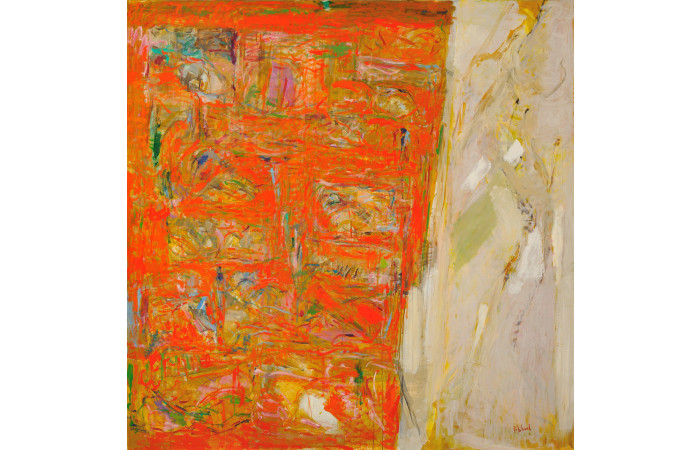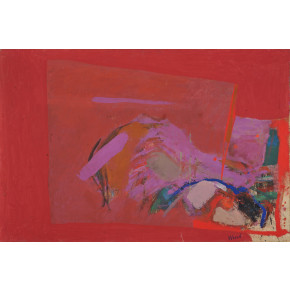Grande Chambre N 16
Description
Executed in: 1987
Medium: Oil on canvas
Size: 160 x160 cm
Signed lower right, Signed and dated on the back
Provenance
Galerie Waddah Faris, Paris.
Collection of Mr and Mrs Joseph Faloughi, Bikfaya.
Acquired from the above by the present owner.
Location
Beirut
Description
Shafic Abboud was born in 1926 in Mhaite, Lebanon spending his childhood between the mountainous region of his birthplace and the city, Beirut. He abandons his engineering studies to pursue a career in art and enrolls at the Academie Libanaise des Beaux Arts in 1945. As a young passionate artist, he was taken by the artistic styles of his professors Cesar Gemayel, Fernando Manetti and Georges Cyr; influential painters who marked the upcoming generation of artists in Lebanon.
In 1947 he makes his way to Paris for the first time and audits the classes of L’École des Beaux Art while also visiting the studios of the neo-cubist artists, Fernand Leger, André Lhote and Othon Friesz. After two years in Paris, he makes his way back to Lebanon and with the help of his former professor Georges Cyr, Abboud presents his first solo exhibition in Beirut at the Centre Culturel Français. He presented figurative paintings depicting folkloric culture, inspired by calligraphy and Persian miniatures, conservatively revealing his Parisian abstract influence.
In 1951, Abboud travels back to Paris where he works three jobs in order to sustain his life, working as a construction painter, a server and a guide at the Louvre. The Lebanese government grants him a scholarship of three years allowing him to officially enroll at the Academie des Beaux Arts in Paris, refining his skills in painting, lithography, and engraving. After 1955, Abboud’s successful artistic career unveils. He participates in a myriad of exhibitions across Europe and Lebanon. In 1959, he becomes the first Lebanese artist to exhibit at the Paris Biennale. The artist began spending more time in Lebanon, teaching and exhibiting from 1970 until the start of the civil war in 1975. In 1978 he decides to move to Paris, and throughout the 1980s, Abboud continued to produce and exhibit artworks around Europe. In 1994, after an absence of sixteen years, Galerie Janine Rubeiz organized a solo show for Abboud in Beirut. Abboud passed away in Paris in 2004 and was buried, per his wishes, in his native village in Mount Lebanon.
A manifesto of freedom and color, Abboud’s paintings bridge the art worlds of Europe and the Middle East. Inspired by the Lebanese landscapes and his childhood memories, the artist’s practice progressed over time from a poetic Lebanese figuration towards an oeuvre which combines the former with a lyrical Parisian abstraction. His practice ultimately evolved to a delicate Abboudian Transfiguration composed of traditional and modern techniques while also incorporating pagan and sacred themes.
In the agreements made with Faris Gallery at the beginning of the 1980s between Shafic and Waddah Faris, several individual exhibitions were planned with a commitment from the gallery to buy a certain number of works in pre-sale. This was a great opportunity for Abboud because it allowed him to work in very large formats and preserve the quality of the support and the colors. He was therefore able to produce museum quality artworks. It is within this framework that Shafic Abboud proposed several themes to Waddah including The Chambre and The Nights.
Shafic Abboud is a painter of the intimate, the bedroom is therefore an ideal place to capture the essence of the intimate through the history that unfolds within and the bodies that occupy it. He was also interested by the multiplicity of its plans, walls, floor and ceiling, which also acted as guidelines and directive surfaces. Christine Abboud, the artists’ daughter, notes: “Regarding the Grande Chambre, it is important not to forget the Petites Chambres, which were worked on at the same time or used as preparatory work. In the studio notebooks, Abboud wrote about the “Grande Chambre n°16”: “Made entirely with oil paint like the last Grande Chambre 10, it is very close to the Petite Chambre”. To each “Grande Chambre n°X” often corresponded a preparatory work called “Petite Chambre n°X”. Petite Chambre 16 was produced between March-April 1987 and the Grande Chambre 16 was produced shortly after that before the exhibition in November 1987.’
Shafic Abboud’s artworks can be found in numerous collections around the world including the Foreign Ministry of Affairs, France, the Government Acquisition, France, the Fonds National d'Art Contemporain, France, the Tate Modern, London, UK, the The British Museum, London, UK, the Centre Georges Pompidou, Paris, France, the Institut Du Monde Arabe, Paris, France, the Musée d’Art Moderne, Paris, France, the Barjeel Art Foundation, Sharjah, UAE the Kunsthandel M.L. Boer, Amsterdam,The Netherlands, the Musée des Beaux-arts of Algiers, Algeria, the Mathaf: Museum of Fine Arts, Doha, Qatar, the Jordan National Gallery of Fine Arts, Amman, Jordan, the Collection Kinda Foundation, Saudi Arabia, and the Nicolas Sursock Museum, Beirut, Lebanon.
Exhibitions
Galerie Faris, Chambre, Paris, 1987.
The works of art which are subject to artist resale royalty rights ('droit de suite') are marked with an * in the description of the work of art. The amount of the royalties is calculated using a sliding scale of percentages of the Hammer Price.
Lots featured on Ans Azura’s platform may be subject to export regulations in the country where they are located and import regulations in the country where they will be shipped to. The location of each Lot is marked in its description.You are responsible for ensuring that you understand and comply with all relevant laws or regulations applicable in relation to the export or import of any Lot that you intend to purchase.
By registering to bid in auctions and by bidding on the Ans Azura platform you agree to the Bidder’s and Buyer’s Terms and Conditions which you may consult here. Please read these Terms and Conditions carefully. By bidding you accept personal liability to pay the Purchase Price consisting of the Hammer Price and the Buyer’s Premium plus the applicable Buyer's Expenses. Please note that the Total Cost Calculator will display the amount including the estimated Buyer’s Premium, exclusive of related artist resale royalties and any shipping expenses and all duties, taxes, VAT, and/or custom processing fees payable by the Buyer.


